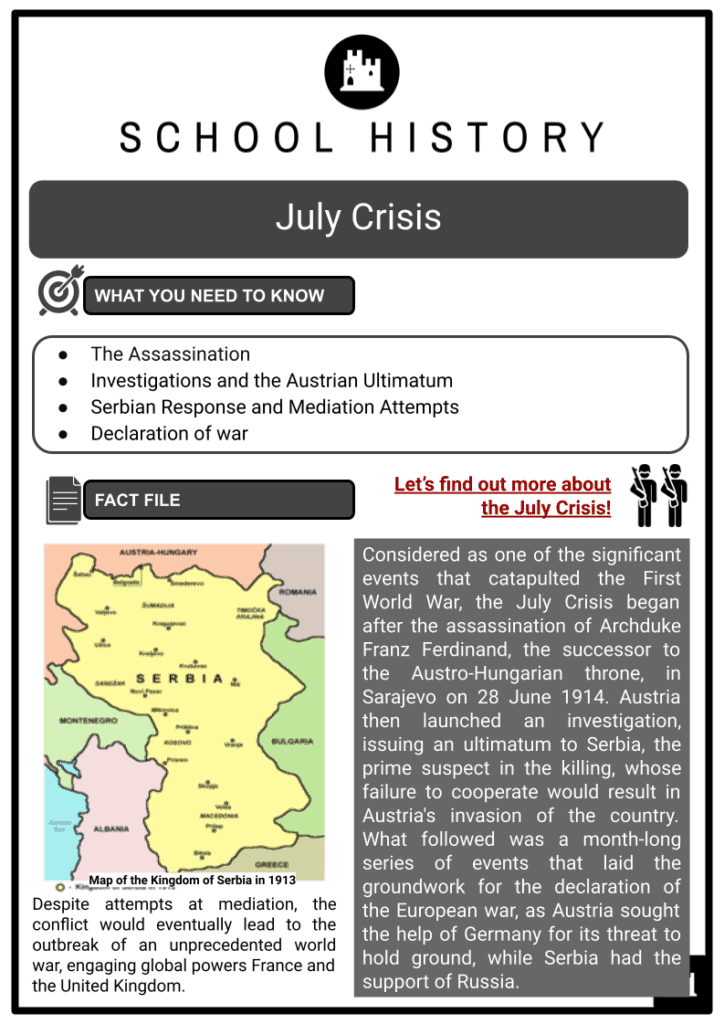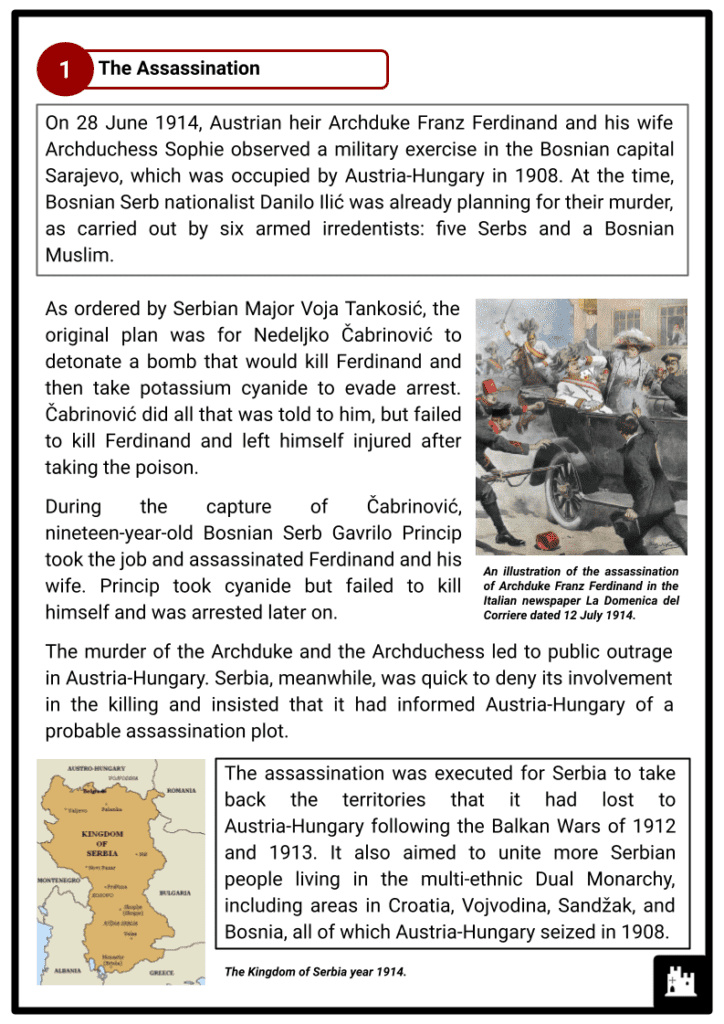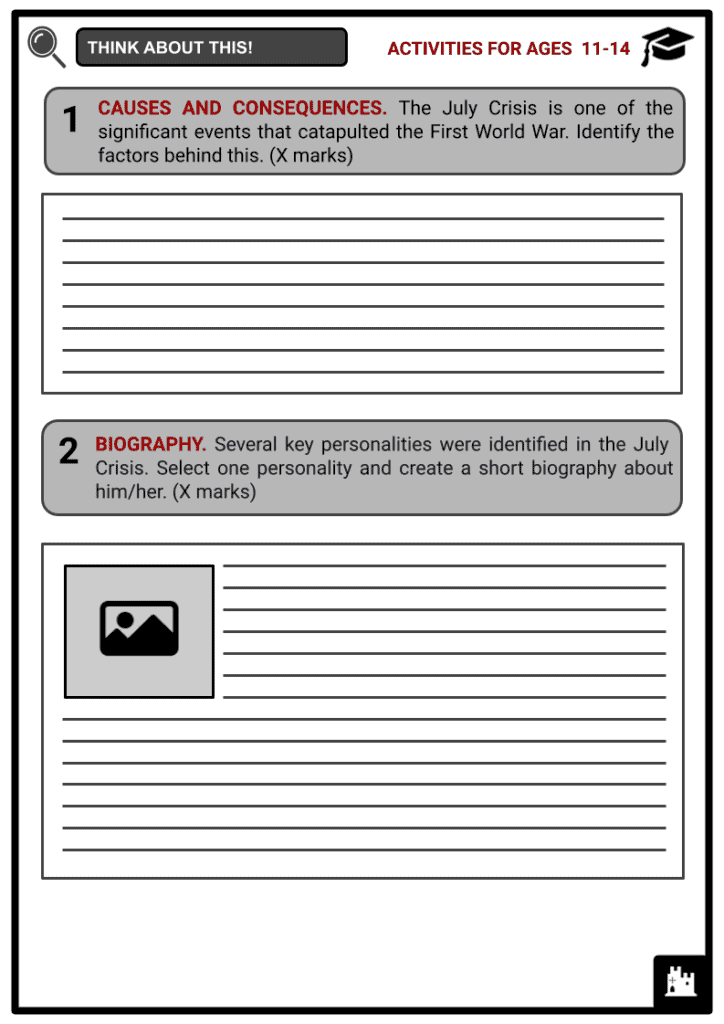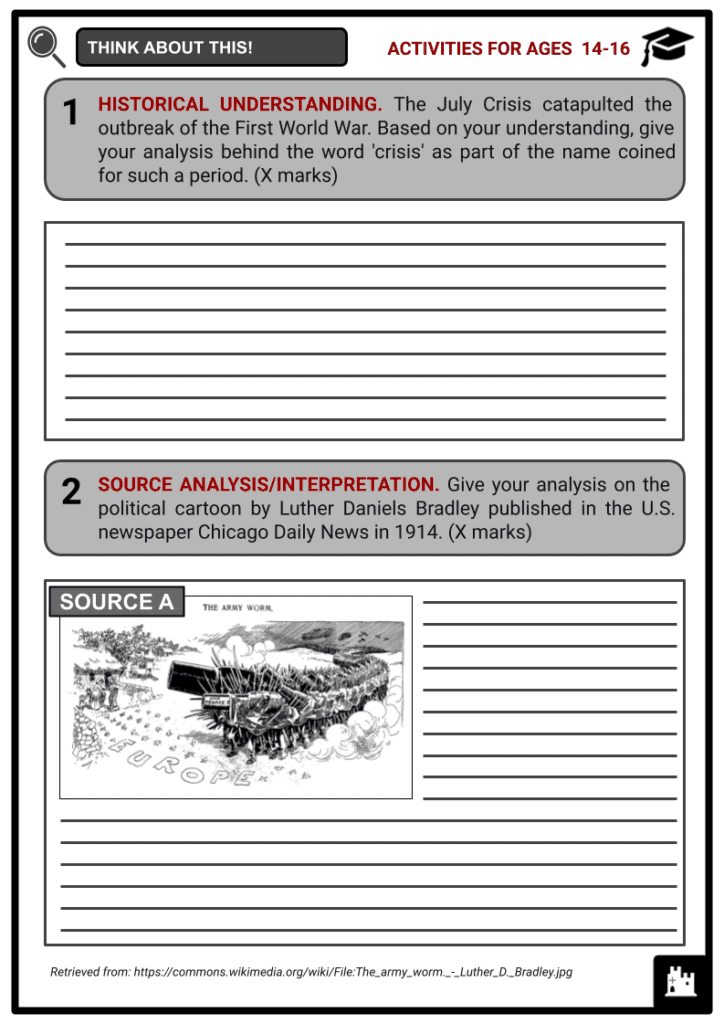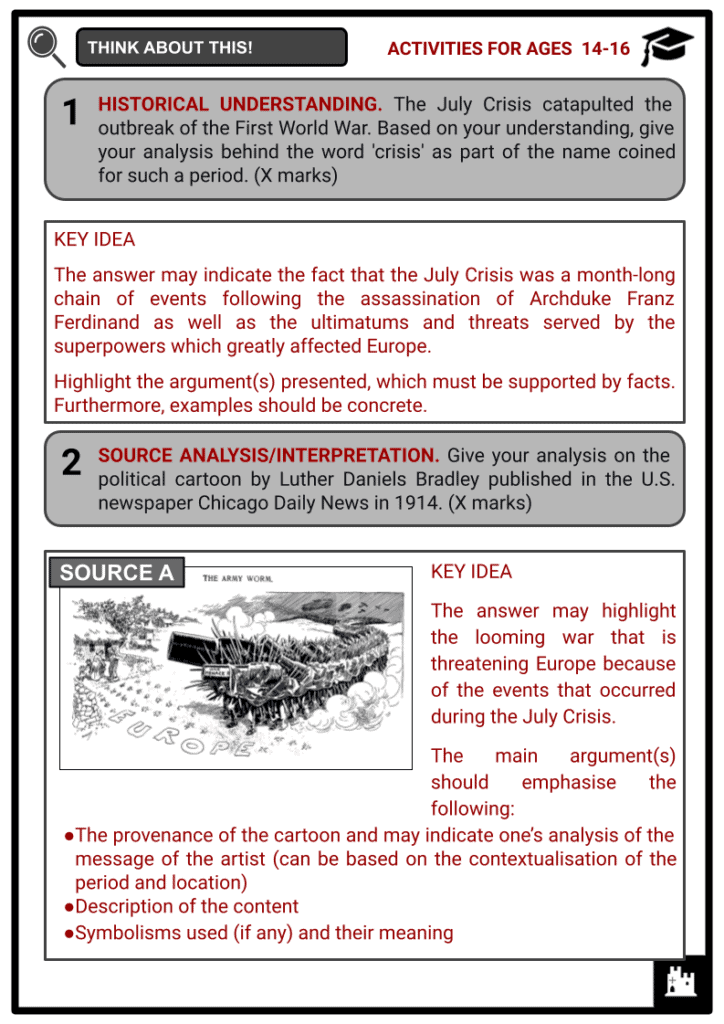July Crisis Worksheets
Do you want to save dozens of hours in time? Get your evenings and weekends back? Be able to teach about the July Crisis to your students?
Our worksheet bundle includes a fact file and printable worksheets and student activities. Perfect for both the classroom and homeschooling!
Summary
- The Assassination
- Investigations and the Austrian Ultimatum
- Serbian Response and Mediation Attempts
- Declaration of war
Key Facts And Information
Let’s find out more about the July Crisis!
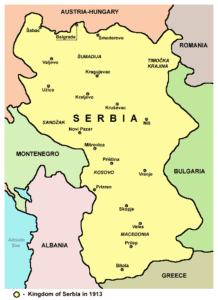
Considered as one of the significant events that catapulted the First World War, the July Crisis began after the assassination of Archduke Franz Ferdinand, the successor to the Austro-Hungarian throne, in Sarajevo on 28 June 1914. Austria then launched an investigation, issuing an ultimatum to Serbia, the prime suspect in the killing, whose failure to cooperate would result in Austria's invasion of the country. What followed was a month-long series of events that laid the groundwork for the declaration of the European war, as Austria sought the help of Germany for its threat to hold ground, while Serbia had the support of Russia.
- Despite attempts at mediation, the conflict would eventually lead to the outbreak of an unprecedented world war, engaging global powers France and the United Kingdom.
The Assassination
- On 28 June 1914, Austrian heir Archduke Franz Ferdinand and his wife Archduchess Sophie observed a military exercise in the Bosnian capital Sarajevo, which was occupied by Austria-Hungary in 1908. At the time, Bosnian Serb nationalist Danilo Ilić was already planning for their murder, as carried out by six armed irredentists: five Serbs and a Bosnian Muslim.
- As ordered by Serbian Major Voja Tankosić, the original plan was for Nedeljko Čabrinović to detonate a bomb that would kill Ferdinand and then take potassium cyanide to evade arrest. Čabrinović did all that was told to him, but failed to kill Ferdinand and left himself injured after taking the poison.
- During the capture of Čabrinović, nineteen-year-old Bosnian Serb Gavrilo Princip took the job and assassinated Ferdinand and his wife. Princip took cyanide but failed to kill himself and was arrested later on.
-
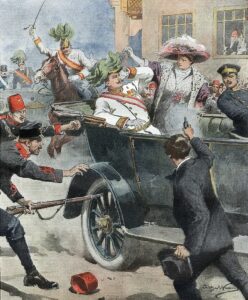
An illustration of the assassination of Archduke Franz Ferdinand in the Italian newspaper La Domenica del Corriere dated 12 July 1914. The murder of the Archduke and the Archduchess led to public outrage in Austria-Hungary. Serbia, meanwhile, was quick to deny its involvement in the killing and insisted that it had informed Austria-Hungary of a probable assassination plot.
- The assassination was executed for Serbia to take back the territories that it had lost to Austria-Hungary following the Balkan Wars of 1912 and 1913. It also aimed to unite more Serbian people living in the multi-ethnic Dual Monarchy, including areas in Croatia, Vojvodina, Sandžak, and Bosnia, all of which Austria-Hungary seized in 1908.
- Čabrinović, Princip, and another young collaborator Trifko Grabež, who were all part of the revolutionary group Mlada Bosna, also known as Young Bosnia, had left their poor lives in Sarajevo and moved to the Serbian capital Belgrade.
- In Belgrade, they became members of underground and conspiratorial organisations, such as the Narodna Odbrana and the so-called Black Hand. The groups were motivated by the idea of a Greater Serbia and were campaigning for anti-Habsburg propaganda.
- Serbian military intelligence officer Dragutin Dimitrijević, more commonly known as Apis, was also part of the secret groups. Apis was one of the Serbian government officials behind the assassination plot.
- After their training in Belgrade and through the help of members of the Black Hand, Čabrinović, Princip, and Grabež returned to Bosnia to carry out the plot. Three more conspirators joined them, including the aforementioned Ilić, Veljko Čubrilović, Civijetko Popović, and a seventeen-year-old collaborator.
Investigations and the Austrian Ultimatum
-
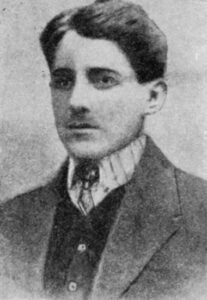
A picture of young Gavrilo Princip, circa 1910. Following the information that Major Tankosić had ordered the murder of the royal couple, Austro-Hungarian and German leaders demanded an investigation on a possible conspiracy between the Serbian and Russian governments.
- The investigation followed the arrest and testimony of Princip, one of the assassins, who cited Serbian involvement in the assassination plot and claimed about a meeting they conducted in France.
- To reduce tensions at the time while Russia was establishing an anti-Austria-Hungary coalition with Romania, Bulgaria, Serbia, Greece, and Montenegro, Serbia declined to comply with certain demands from Austria-Hungary and Germany.
- However, Germany was already preparing for war during this period. The Germans wanted the Austro-Hungarians to immediately charge the Serbians for them to catch the Russians and the French off guard.
- Following this, the Austro-Hungarian government issued an ultimatum aimed at provoking the Serbians to declare war.
- Among the demands in the ten-point ultimatum were the banning of anti-Austrian propaganda in Serbia, the removal of anti-Austrian military officials, the dismissal of Serbian educators who had motivated anti-Austrian sentiment, and the participation of Serbia in a joint investigation of its military personnel and civilians which will be led by Austrian officials.
- The then British Royal Navy chief, Winston Churchill, branded the ultimatum as “the most insolent document of its kind ever devised.”
-
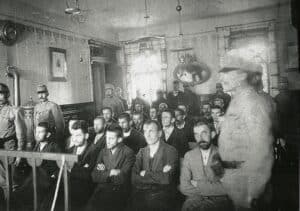
Members of the Young Bosnia organisation at the 1914 Sarajevo trial following the assassination of Archduke Franz Ferdinand and his wife Archduchess Sophie. Front row, from left to right: Trifko Grabež, Nedeljko Čabrinović, Gavrilo Princip, Danilo Ilić, and Miško Jovanović. On 5 July 1914, Kaiser Wilhelm II of Germany issued the famous ‘blank cheque’ to Vienna signifying that Austria-Hungary could proceed on how it wanted to and they would back them if Russia interfered.
Serbian Response and Mediation Attempts
- On 23 July 1914, four weeks into the conflict, Serbia received the ultimatum from Austria-Hungary. They were given two days to respond.
- Serbia first consulted Russia. The city of St. Petersburg proposed to publicly condemn the Austrian ultimatum, without offering military support since the Russian defence was still not as ready as that of Germany.
- To avoid the outbreak of war, British foreign minister Sir Edward Grey offered a mediation meeting between all nations involved in the crisis, only to receive no support from Berlin and Vienna.
- On 24 July 1914, Serbia held a Council of Ministers meeting and discussed the demands in the Austrian ultimatum which they called “wholly unacceptable to the Kingdom of Serbia as a sovereign state.”
- An extension of the deadline of the ultimatum was supposed to be asked from Vienna, as well as the permission for mobilisation in case of a war outbreak.
- On 25 July 1914, mechanisms for partial mobilisation were already in place and were executed the next day.
- Before the time limit expired, Serbia answered the ultimatum. It agreed to most of the demands, except for the Austrian-led joint investigation, arguing that it was a violation of their sovereignty. They maintained their position that the Serbian government had no participation in the assassination plot.
Declaration of war
- After learning that Britain would be engaged in case the crisis escalated into a war, the German Chancellor tried to offer mediation to the Austro-Hungarians, but it was already too late.
- On 28 July 1914, Austria launched a war against Serbia. What came after was a series of war declarations from the European powers.
Russia quickly gathered its military forces against Austria-Hungary. Germany, meanwhile, declared war on Russia on 1 August 1914.
- By 4 August 1914, Britain found itself at war with Germany, the same day when the latter annexed Belgium and two days after it occupied Luxembourg. This scheme to attack the two neutral territories was part of Germany’s so-called Schlieffen Plan, designed to evade a prolonged two-front war.
- The British allies Australia, New Zealand, Canada, India, and South Africa later delivered their declarations of war on Germany.
- As predicted, the onset of the First World War took place in Serbia, as Austria-Hungary reached the border to invade Serbian territories.

